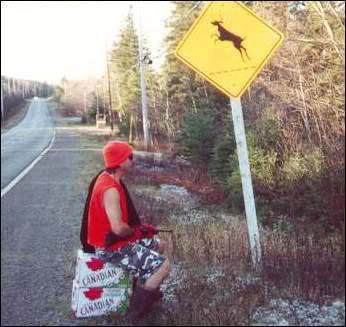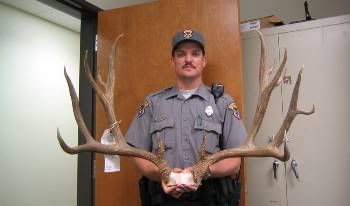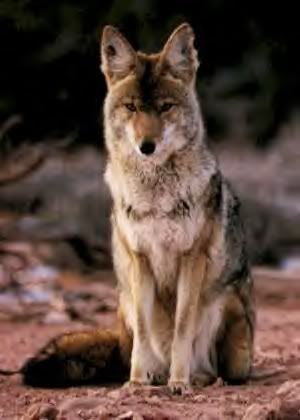Utah March 3
Wyoming March 15
New Mexico March 28
Colorado April 6
Nevada April 18
Kansas April 29
Oregon May 15
Washington May 26
California June 1
Montana June 1
Idaho June 5
Arizona June 8
South Dakota July 23
Utah March 3
Wyoming March 15
New Mexico March 28
Colorado April 6
Nevada April 18
Kansas April 29
Oregon May 15
Washington May 26
California June 1
Montana June 1
Idaho June 5
Arizona June 8
South Dakota July 23
Wednesday, January 7, 2009
Cougar attacks dogs in Gimlet. Fish and Game officers relocate big cat after confrontation
Idaho Department of Fish and Game
A two-year-old male cougar sits in the snow at its relocation site near the Little Wood River north of Carey on New Year’s Eve. Idaho Department of Fish and Game officers transferred the big cat to the remote area after it tangled with two dogs in the Gimlet neighborhood south of Ketchum.
Gimlet resident Lon Stickney was treated to the kind of surprise no pet owner would ever wish for when he stepped out of his home on New Year’s Eve to check on his two dogs.
Glancing around for the pair of 60- to 70-pound mixed-breed dogs, Stickney, a pilot for Sun Valley Heli-Ski, found them in the fight of their lives with a cougar. Stickney’s home is located near the Big Wood River’s forested corridor just north of the confluence with the East Fork.
Calmly retelling the story last Friday, Stickney said all he could see when he approached the confrontation was a tumbling ball of fur. Wanting to do something to save his dogs, he grabbed a large leaf rake and approached the melee.
“I poked at it and this cougar looked up,” he said. “He started walking towards me.”
Seeing the cougar’s approach, Stickney gathered up the two bleeding dogs and retreated to the house. Soon after, he and his wife, Gail Stickney, glanced out their living room window to see the cougar’s eyes fixated at them through the thin pane of glass. The cougar stepped away.
“It turned and went under my deck,” he said.
Stickney quickly decided he should call the authorities for help. He telephoned the Blaine County Sheriff’s Office, which contacted Idaho Department of Fish and Game Conservation Officer Lee Garwood, a Hailey resident.
Sun Valley Chamber of Commerce
Within an hour, Garwood and Rob Morris, another Fish and Game conservation officer based in the Wood River Valley, arrived at the Stickneys’ home. Checking under the couple’s deck, the two officers saw the cougar staring back. After assessing the situation and consulting with Fish and Game officials in Jerome, Garwood and Morris proceeded to tranquilize the cornered animal.
The cougar was a young male—likely just 2 years old—and was probably searching for a home range of its own, Garwood speculates. He said there have been a number of cougar sightings in the lower East Fork area in the past month or so. The cougar they captured may be the same animal, he said.
Garwood said it may also be the same animal that attacked dogs twice over the summer in the Elkhorn and Triumph areas.
The big cat was likely pushed into the river corridor by recent snows that have forced its main prey base—elk and mule deer—out of their summer ranges, Garwood speculates.Once the cougar was under control and placed in a transport box, Garwood and Morris drove the 80-pound predator over to the Little Wood River drainage north of Carey. After the tranquilizer had worn off enough to allow the cougar to safely move out on its own, the two officers released the cat.
Garwood said Stickney handled the situation well by bringing his dogs indoors and calling the authorities for help. He said people should never try to handle that kind of situation on their own.
“Let us handle it,” he said.Garwood has several other winter-related wildlife tips for locals. First, he said he likes to hear from the public when they encounter wildlife such as moose, cougars, gray wolves and black bears. Hearing reports from the public can help Fish and Game officers develop a picture of which areas individual animals may be occupying.
Garwood also cautioned that recent snows have really begun to limit the available habitat for local deer and elk. He said people who run into wildlife while out recreating in the snow should reconsider their plans and find an alternative spot to play, in order to let the animals conserve their energy.
“The world has become a little smaller now because of the snowfall,” he said.
People should also be careful with their dogs, no matter how well behaved they think they are, Garwood said.“The chase instinct kicks in,” he said.
Garwood said local pet owners should be aware that all of Blaine County is cougar country and should act accordingly. He said that when letting a dog outside, people should turn the porch light on and make sure the coast is clear.
“If you can supervise the animal, that’s best,” he said. “There’s always a miniscule chance that a cougar will be passing through.”
To this, Stickney can now surely attest.“They’re around and they’re not afraid of anybody,” he said.
Except for a bit of soreness and the stitches to mend their torn sides, the Stickneys report that their two dogs—Daphne and Ruby—are doing fine.
Hunters and others presented many proposed changes to Idaho hunting rules. Here are a couple that may effect mule deer hunters:
You will be able to go find your wounded buck with a dog and, there are to be travel restrictions in units 66a and 76. This is supposedly to help more deer survive the hunt.

Biologists watch for lousy deer
———————————–
OUTBREAK – A mule deer found dead this spring near Riggins was infested with Bovicola tibialis, an exotic louse not previously reported in Idaho.
Infestations of native lice are not uncommon on deer and elk, Idaho Fish and Game officials say. But the exotic lice, possibly imported with exotic fallow deer, have been associated with hair-loss syndrome and ailing deer in Washington and Oregon in 2007 and 2008.
Some population declines have been recorded in Washington.
Infested deer tend to chew off the tips of their outer hair, exposing the under hair, which is much lighter and can make the animals appear white.


HANDGUNS FOR SHORT-RANGE HUNTS
Background: Current rules prohibit the use of handguns in short-range weapon big game hunts.
Short-range weapon hunts take place in areas where the ballistics and range capabilities of high-powered rifles are a safety concern.
Several handgun cartridges are capable of taking big game but have limited ballistics and would not pose a significant safety concern in short-range weapon hunts.
Handguns would not be allowed in archery and muzzleloader hunting season.
Proposal: Allow the use of handguns that use straight-walled cartridges not originally developed for rifles.
ATV RESTRICTIONS IN UNITS 66A AND 76
Background: Fish and Game has motorized vehicle restrictions in some hunting units to reduce conflicts between hunters and to help buck and bull survival. ATVs, motorcycles and other motorized off-road vehicles are limited to roads capable of being driven on by a full-sized vehicle.
Neither mule deer nor elk populations are meeting management objectives in 66A and 76.
Proposal: Apply the motor vehicle restrictions rule in these two units during the fall hunting season.
DOGS FOR TRACKING WOUNDED BIG GAME
Background: Current rules prohibit the use of dogs while big game huntingexcept for black bear and mountain lion. Other states allow the use of blood-trailing dogs.
Proposal: Allow one blood-trailing dog controlled by leash during lawful hunting hours and within 72 hours of hitting a big game animal to track wounded animals and aid in recovery.
LEFTOVER AUGUST CONTROLLED HUNTS
Background: Controlled hunt permits left over after the June drawing are available in a second drawing by Aug. 25. Some hunts end during August, which leaves inadequate time to hunt.
Proposal: Allow leftover controlled hunt permits ending during August to be available immediately after the first drawing on a first-come, first-served basis.
LIGHTED ARROW NOCKS
Background: Current rules prohibit the use of any electronic device attached to an arrow. Battery-powered lighted nocks do not affect performance or harvest efficiency of arrows.
Proposal: Allow the use of lighted nocks while hunting big game.
POSSESSION AND SALE OF BIG GAME BONES
Background: Current state rules allow antlers, horns (with the exception of bighorn sheep), parts of mountain lions and bears, and elk teeth from animals that have died of natural causes or been lawfully harvested to be legally possessed or sold.
Proposal: Allow the possession or sale of bones from lawfully harvested game or animals that died naturally.

Idaho Fish and Game claims another trophy Mule Deer.
—————————————
A Wisconsin man, aided by a friend from Jerome, Idaho and hunting on a highly visible Idaho Super Tag, shot this buck with a rifle in a unit that was open for muzzleloader hunting. When questioned, the men claimed to have shot at the deer, with a muzzleloading rifle, in the correct unit, only to have it run across the road where it was finished off with a rifle. The kill was reported by another man who had hopes of killing the buck himself and who had been keeping track of the monster for some time previous to the hunt. This story does go to show that there was at least one good buck still left in Idaho at the time.
Lesson: Don’t finish off your archery or muzzleloader buck with a rifle.

Trophy wolf hunting set for Oct. 1
Posted: Wednesday, May 28th, 2008
BY: Joy Ufford
G&F sets limit at 25 wolves for 4 hunt areas
A total “harvest quota” of 25 trophy-game gray wolves, in a hunting season suggested to open Oct. 1 this year in northwest Wyoming, is a new element in this year’s Wyoming Game and Fish (G&F) annual release of proposed hunting season changes.
“The structure of the season will be an Area Harvest Quota Limitation, in which the season for each wolf hunt area will close when the harvest quota for that area has been reached,” said G&F spokesman Eric Keszler. “The proposal will establish wolf seasons and harvest quotas in four hunt areas in the Trophy Game Area of northwest Wyoming.”
A harvest quota is defined in the new regulation draft as “the total number of gray wolves for a single hunt area that may be legally taken by licensed hunters during any single gray wolf hunting season within the area where gray wolves are classified as trophy game animals.”
General licenses will cost $15 for Wyoming hunters, $150 for nonresident hunters.
Four hunt areas
The four new hunt areas are drawn from the designated trophy-game area with exceptions for national park lands. (See Wyoming Game and Fish map.)
The Green River and Gros Ventre Hunt Areas each have a harvest quota of five animals taken with an Oct. 1 opening date and closing on Nov. 30 and Nov. 15, respectively, or when the quotas are reached. The Sunlight (five wolves) and Francs Peak (10 wolves) Hunt Areas would also open Oct. 1 and run through Nov. 30 or until the quotas are filled.
The Gros Ventre Hunt Area (HA 3) begins at the junction of Highway 26/287 with Union Pass Road then follows south along Forest Service Road 600 and the Bridger-Teton National Forest boundary to Highway 189/191 where it follows the highway northwest through Bondurant to Hoback Junction, up to Highway 22 in Jackson and along Highway 22 through Wilson to the Idaho line and zigzags around Grand Teton Park and John D. Memorial Parkway. It excludes all lands within Teton Park and the National Elk Refuge.
The Green River Hunt Area (HA 4) begins where Highway 26/287 crosses the west boundary of the Wind River Reservation, south to the Continental Divide then southeast along the Divide to go west along the Middle Fork of Boulder Creek to the BTNF boundary and northwesterly to Union Pass Road.
The Sunlight Hunt Area (HA 1) begins at the junction of Highway 120 at the Montana state line, runs south to the intersection with Highway 14/16/20 in Cody, then west to Yellowstone and along the park boundary to the state line and back to Highway 120.
The Francs Peak Hunt Area (HA 2) begins at the intersection of Highway 120 and Highway 14/16/20 in Cody, runs south along the highway to the Greybull River, southwest along the river to the Shoshone national Forest, south along that boundary to the Wind River Reservation and west and south to where it meets Highway 26/287, then to the east boundary of the John D. Memorial Parkway and up along Yellowstone’s east boundary to meet back at highway 120 in Cody.
Draft rules
Draft regulations state a hunter must confirm whether or not a hunt area’s quota is met before hunting there. Only legal firearms and archery equipment can be used; it is illegal to use radio-tracking equipment to take a trophy wolf, the new regulations say.
The bag and possession limit for licensed hunters will be one wolf during the calendar year and that can be any gray wolf in the applicable hunt area.
Hunters must report taking a trophy wolf within 24 hours by calling (866) 373-5805 any time of day or night. They also must retain the skull and unfrozen pelt, with visible evidence of sex attached naturally, and present them to a district game warden, district wildlife biologist or G&F personnel at a regional office within five days for collection of biological samples. Radio-tracking devices such as electronic collars or ear tags must be surrendered to the G&F as well.
Conservative start
G&F Wildlife Assistant Chief Bill Rudd said last week the proposed wolf hunting season and harvest quota are “an extremely conservative approach to wolf hunting in Wyoming.”
U.S. Fish and Wildlife Services (FWS) Wolf Recovery Coordinator Ed Bangs, who led the recovery project to the gray wolf’s March delisting, agreed this week.
“I think the WGFD recommendation of 25 tags as a start is a good one,” he said.
Bangs said he expects most prospective Wyoming wolf hunters will buy tags to go along with another big-game hunt.
“Most hunters won’t ever hunt for wolves but take them while hunting something else,” he said. “Same thing here – it will be elk and deer hunters that harvest wolves during the fall big game season.”
The Idaho Fish and Game Commission met last week and chose to allow higher hunting quotas to take Idaho’s wolf population back to its 2005 population level.
Bangs said, “…In Idaho the (Fish and Game) Commission ignored the IDFG recommendations and passed the maximum wolf kill under wolf-hater pressure, to get the wolf population down to the lowest level in their management plan (but still 518 wolves) – so we’ll see how good (G&F) is at ‘wolf’ politics.”
The IFGC set a wolf population goal of 518 wolves and adopted seasons, limits and rules for this year.
The Idaho Wolf Population Management Plan, approved in early March, calls for managing wolves at a population level of between 2005-2007 levels (518 to 732) wolves for the first five years after delisting. With an annual estimated growth rate of 20 to 30 percent, Idaho’s population could exceed 1,000 wolves before the state’s new hunting seasons open, Sept. 15 and Oct. 1. Idaho hunt areas will be open through Dec. 31 with possible season extensions if quotas aren’t met.
In Wyoming wolves are increasing at about 24 percent annually, said Rudd.
“Wolves… in Wyoming and can sustain much higher harvest than we are proposing through hunting,” he said. “Removing some wolves through controlled hunting can also help prevent wolf-livestock conflicts in some cases.”
More information
The proposed wolf hunting season, hunt areas and regulations are included in G&F’s “Chapter 47: Gray Wolf Hunting Seasons.” To see proposed wolf hunting seasons and associated information, visit http://gf.state.wy.us/services/education/wolves/index.asp.
A public comment period on this proposal as well as other G&F hunting issues is open through 5 p.m. on July 3. The G&F Commission will take actions on the proposed trophy wolf season and other hunting issues when it meets in Dubois, July 30-Aug. 1.
Public meetings are planned across Wyoming but mainly in the western part of the state for discussion and comments on the wolf season and other 2008 hunting issues including mountain lion seasons, furbearing and trapping seasons, taxidermy regulation and issuance of licenses, special points and interstate game tags.
G&F will hold the Pinedale meeting June 10 at 7 p.m., at the Pinedale Library. On June 11, a meeting will be held at 7 p.m. at the Antler Inn. Other meetings are set for Green River (June 9), Laramie (June 9), Lander (June 10), Sheridan (June 11), Cody (June 12) and Casper (June 12).
Copies of all regulation changes and seasons can be viewed at the public meetings or by contacting the Casper Game and Fish office at (307) 473-3400. All comments must be in writing and must be submitted at the public meetings or mailed to: Wyoming Game and Fish Department, Wildlife Division, ATTN: Regulations, 3030 Energy Lane, Casper, WY 82604.


A recent newspaper article, from the Boise area, stated that the Idaho Game and Fish now estimates state-wide coyote numbers to be around 50,000. Is it any wonder that Idaho has so few mule deer? Idaho mule deer will need to look both ways – twice, before lowering their heads to eat or drink.
Never mind lions, wolves, and bears.
Maybe the wolves will kill the coyotes. I don’t think the mule deer will win, either way.

Before I started hunting mule deer in Idaho it must have been fabulous. I will tell you how good it was in the early 80’s when I started. If I saw another hunter in the same canyon in which I was hunting, it was rare. And then, they or I would usually leave because it was too crowded. The hunting season ran from early August to mid January depending on where you hunted. Tags were over-the-counter. In some areas, you could kill 2 bucks. Non-resident tags were priced reasonably. Resident tags were a steal. You could hunt where you wanted. Wardens were seldom seen. Big bucks were common. Seasons were long and you could hunt with multiple weapons in multiple areas. Hunting during the rut was common practice, and deer were two to three times more plentiful than they are today.
——————–
Now Idaho has done a mock-survey to see what is wanted
I cannot take credit for discovering this survey on my own. It was brought to my attention by Don of Buckhuntersblog. Here is the link to an Idaho Mule Deer hunter survey –> IDAHO DEER HUNTER SURVEY.

It’s time to apply, if you want to hunt mule deer in Idaho. Idaho has been over-priced since the early 90’s, and in spite of a “mule deer recovery” plan, there still aren’t many more mule deer in the great Gem state. From May 1 to June 5, you can apply for an Idaho deer tag.
For more info click IDAHO HUNT INFO